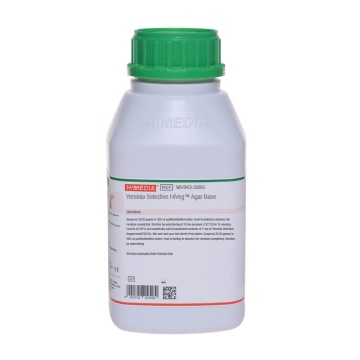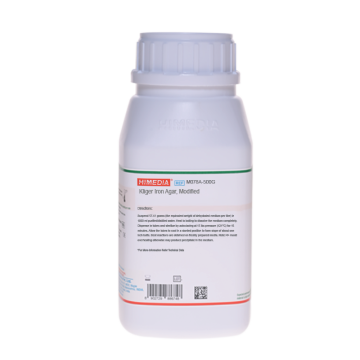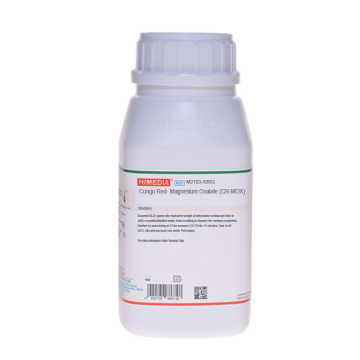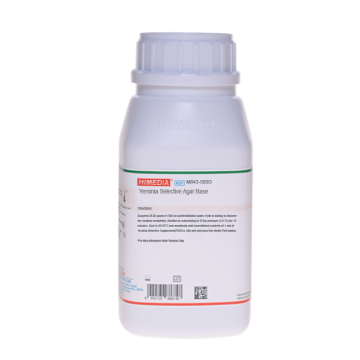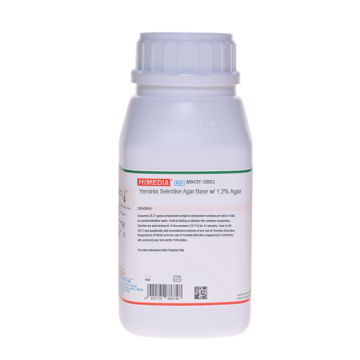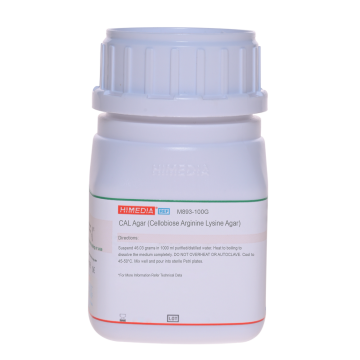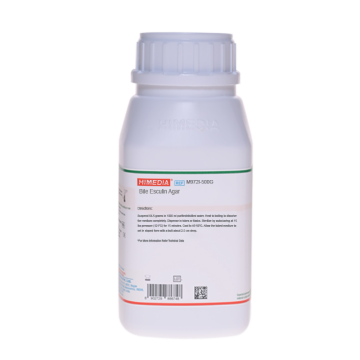 Your enquiry has been submitted
Your enquiry has been submitted
SSDC agar
Intended Use
Recommended for the selective isolation and differentiation of pathogenic Yersinia enterocolitica from clinical and food samples. The composition and performance criteria of this media is as per the specification laid down in ISO 10273 :2017.
Composition**
ISO 10273 Specification Agar : Salmonella/Shigella agar with sodium desoxycholate and calcium chloride (SSDC)
M1703: SSDC agar
| Ingredients | g / L |
|---|---|
| Peptone# | 5.000 |
| HM extract## | 5.000 |
| Yeast extract | 5.000 |
| Lactose | 10.000 |
| Bile salt | 8.500 |
| Sodium deoxycholate | 10.000 |
| Calcium chloride | 1.000 |
| Sodium citrate | 10.000 |
| Sodium thiosulphate, pentahydrate | 8.500 |
| Iron (III) citrate | 1.000 |
| Brilliant green | 0.0003 |
| Neutral red | 0.025 |
| Agar | 15.000 |
Final pH ( at 25°C): 7.4±0.2
**Formula adjusted, standardized to suit performance parameters
Key : # - Equivalent to Enzymatic digest of animal tissues : ## - Equivalent to Meat extract
Directions
Suspend 75.94 gram (the equivalent weight of dehydrated medium per litre) in 1000 ml purified/distilled water. Heat to boiling by swirling regularly to dissolve the medium completely. DO NOT AUTOCLAVE OR DO NOT OVERHEAT. Cool to 45-50°C in water bath. Mix well and pour into sterile Petri plates. To avoid precipitation of bile salts, do not exceed the cooling phase for more than one hour.
Principle And Interpretation
SSDC Agar is suggested for detection of presumptive pathogenic Yersinia enterocolitica in accordance with ISO Commiteee under specifications 10273 :2017(1). Peptone, yeast extract provide carbon, nitrogen sources, long chain amino acids, vitamins and other essential growth nutrients. Lactose is the fermentable carbohydrate. Lactose positive organisms appear red due to lactose fermentation and neutral red indicator. Brilliant green, bile salts and thiosulphate selectively inhibit gram positive and coliform organisms. Certain species of enteric organisms reduce sodium thiosulphate to sulphite and H2S gas. Yersinia enterocolitica colonies appear as colourless colonies.
Pathogenic Y.enterocolitica strains, in particular those of serogroup 0:3 are known to tolerate high concentration of bile salts and deoxycholate. Due to the high content of bile salts along with the high sodium citrate concentration and the brilliant green content other accompanying microbial flora gets almost completely or completely inhibited.
Type of specimen
Clinical samples - faeces; Food samples
Specimen Collection and Handling
For clinical samples follow appropriate techniques for handling specimens as per established guidelines (2,3). For food samples, follow appropriate techniques for sample collection and processing as per guidelines (1). After use, contaminated materials must be sterilized by autoclaving before discarding.
Warning and Precautions
In Vitro diagnostic Use. For professional use only. Read the label before opening the container. Wear protective gloves/ protective clothing/eye protection/ face protection. Follow good microbiological lab practices while handling specimens and culture. Standard precautions as per established guidelines should be followed while handling clinical specimens. Safety guidelines may be referred in individual safety data sheets.
Limitations
- Individual organisms differ in their growth requirement and may show variable growth patterns on the medium.
- Each lot of the medium has been tested for the organisms specified on the COA. It is recommended to users to validate the medium for any specific microorganism other than mentioned in the COA based on the user’s unique requirement.
Performance and Evaluation
Performance of the medium is expected when used as per the direction on the label within the expiry period when stored at recommended temperature.
Quality Control
Appearance Light yellow to pink homogeneous free flowing powder
Gelling Firm comparable with 1.5% Agar gel.
Colour and Clarity of prepared medium Orange red coloured, clear to slightly opalescent gel forms in Petri plates.
Reaction Reaction of 7.59% w/v aqueous solution at 25°C. pH : 7.4±0.2
pH 7.20-7.60
Cultural Response Productivity : Cultural characteristics observed after an incubation at 30±1°C for 21 ± 3 hours. Selectivity : Cultural characteristics observed after an incubation at 30±1°C for 21 ± 3 hours.
| Organism | Inoculum (CFU) | Growth | Characteristic reaction |
|---|---|---|---|
| Productivity | |||
| Yersinia enterocolitica ATCC 9610 (00038)* | 103-104 | good-luxuriant | colourless round colonies, approximately 1mm diameter. A finely granulated centre can be seen under 10X magnification |
| Yersinia enterocolitica ATCC 23715 (00160)* | 103-104 | good-luxuriant | colourless round colonies, approximately 1mm diameter. A finely granulated centre can be seen under 10X magnification |
| Selectivity | |||
| Escherichia coli ATCC 25922 (00013*) | >=104 | inhibited | |
| Escherichia coli ATCC 8739 (00012*) | >=104 | inhibited | |
| Staphylococcus aureus subsp. aureus ATCC 6538 (00032*) | >=104 | inhibited | |
| Staphylococcus aureus subsp. aureus ATCC 25923 (00034*) | >=104 | inhibited | |
Key : (*) Corresponding WDCM numbers.
Storage and Shelf Life
Store between 10-30°C in a tightly closed container and the prepared medium at 2-8°C. Use before expiry date on the label. On opening, product should be properly stored dry, after tightly capping the bottle in order to prevent lump formation due to the hygroscopic nature of the product. Improper storage of the product may lead to lump formation. Store in dry ventilated area protected from extremes of temperature and sources of ignition. Seal the container tightly after use. Product performance is best if used within stated expiry period.
Disposal
User must ensure safe disposal by autoclaving and/or incineration of used or unusable preparations of this product. Follow established laboratory procedures in disposing of infectious materials and material that comes into contact with clinical sample must be decontaminated and disposed of in accordance with current laboratory techniques (2,3).
Reference
- Microbiology of the food chain Horizontal method for the detection of pathogenic Yersinia enterocolitica, ISO 10273 : 2017
- Isenberg, H.D. Clinical Microbiology Procedures Handbook 2nd Edition.
- Jorgensen, J.H., Pfaller, M.A., Carroll, K.C., Funke, G., Landry, M.L., Richter, S.S and Warnock., D.W. (2015) Manual of Clinical Microbiology, 11th Edition. Vol. 1.
| Product Name | SSDC agar |
|---|---|
| SKU | M1703 |
| Product Type | Regular |
| Physical Form | Powder |
| Origin | Animal |
| Packaging type | HDPE |
| References | 1. International Organization For Standardization (ISO), 1994, Draft ISO/DIS 10273.2.Isenberg, H.D. Clinical Microbiology Procedures Handbook 2nd Edition. |
| Customized Product Available | No |




